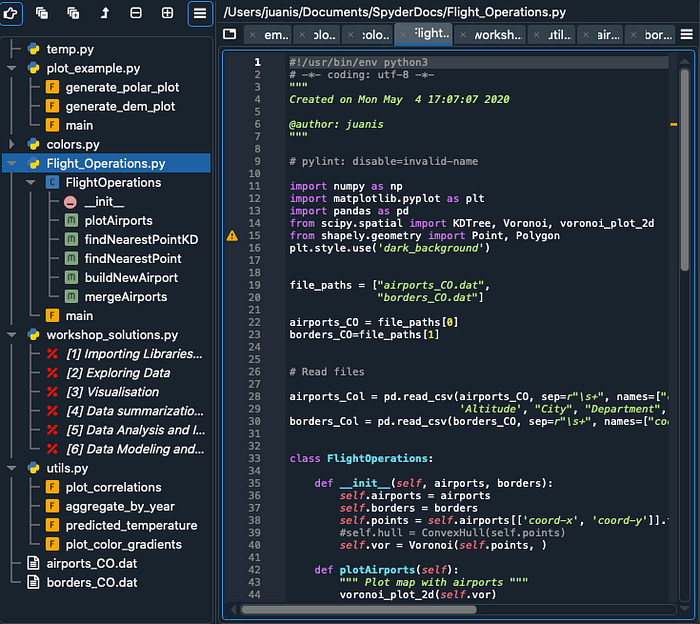Integrated Development Environments

Recently I came across an article from Berkely highlighting the most in-demand programming languages in 2021. Without any doubt, Python language continue to attract Machine Learning enthusiasts and experienced Data Scientists alike and continue to rank high among many programming languages. Without a doubt, for any of these programming languages the code needs to be written, executed and tested to build applications. After the code is written, a programming language interpreter allows it to be executed. Testing and debugging the code are essential steps before releasing the final application ready for launch. An Integrated Development Environment stitches these step-wise activities
My computer journey in the past decades includes learning many languages starting from an assembler language to manipulate 36-bit Univac registers to most of the modern languages on the ranked-pie-chart shown above. Irrespective of the language proficiency, Python users experiment with more than one development environments before finding their favorite environments. So far, I have used Jupyter, PyCharm, Spyder, Visual Code, and looking for opportunities to try other integrated development environments.
The Integrated Development Environment
Generally speaking, development environment combines a ‘text editor’ and a ‘runtime environment’ as an integrated platform. While you use the text editor to create your code Python and other languages) for your application, the runtime environment provides an integrated platform to execute and debug the code along with a console to monitor the execution environment.
Instead of debating on the top IDEs for programmers which could be immediately disputed to suit individual choice, here let us quickly roundup a few popular IDEs used by Data Scientists. Not in any specific priority amongst the popular IDEs, we will have a brief understanding of Jupyter Notebook, PyCharm, Spyder, Sublime, Atom, and Visual Studio Code.
Jupyter Notebook
For the implementation of Python under the .NET Framework, IPython (Interactive Python) was first introduced two decades ago as a command shell for interactive computing using a command shell for interactive computing, originally developed for the Python programming language. In 2014, Project Jupyter was spun-off with a goal to “develop open-source software, open-standards, and services for interactive computing across dozens of programming languages” and the name emphasized three core programming languages supported by Jupyter, which are Julia, Python and R.
Jupyter can be installed from here.

The extension of Jupyter Notebook is Jupyter Lab which provides much more capabilities, like a visual debugger
The next generation of Jupyer Notebook is called Jupyter Lab, a web-based interactive development environment for Jupyter notebooks, code, and data. Jupyter Lab is flexible: configure and arrange the user interface to support a wide range of workflows in data science, scientific computing, and machine learning. JupyterLab is extensible and modular: write plugins that add new components and integrate with existing ones. JupyterLab offers a general framework for interactive computing and data science in the browser, using Python, Julia, R, or one of many other languages.

To install Jupyter Lab, follow this link.
PyCharm
PyCharm is a cross-platform IDE that provides consistent experience on the Windows, macOS, and Linux operating systems was developed by Jet Brains in February of 2010. PyCharm offers many Python features like code/ error highlighting, Git integration, and a powerful graphical debugger.
Though the professional PyCharm edition comes with a set of tools and features, the Community and Edu editions are free open-source projects, has a a smaller set of features. A comparison of available features in free and commercial edition is found here.
Spyder IDE
Spyder is an open-source cross-platform open-source IDE. The Python Spyder IDE is written completely in Python. It is designed by scientists and is exclusively for scientists, data analysts, and engineers.
Spyder is a free and open source scientific environment written in Python, for Python, and designed by and for scientists, engineers and data analysts. It features a unique combination of the advanced editing, analysis, debugging, and profiling functionality of a comprehensive development tool with the data exploration, interactive execution, deep inspection, and beautiful visualization capabilities of a scientific package.

Visual Studio Code
Microsoft Visual Studio has been there fore more than two decades. With the popularity of open-source software, Microsoft introduced now widely used IDEs is Visual Studio Code (VS Code). VS Code IDE is used in many languages like Python, C, C#, and JavaScript developers. VS Code is free, lightweight, and open source. But it also offers a paid version for companies.
VS Code has many advantages, especially for beginners, as it provides hits and pointers to help when you define a function or a class or have a minor syntax error. VS Code also has good integration with PyLint, a Python linter used to check errors in the code. Another advantage of using VS Code is how easy it is to perform unit testing and REPL (read-evaluate-print loop) operations.
Takeaways
No matter which most in-demand programming language you use in your application development, experimenting with different IDEs or text editors will offer you a personal choice. Because, IDEs also give an integrated platform beyond editing the source codes, they also have syntax highlighting, running and debugging before deployment will accelerate development process.
